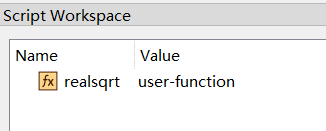Products
Solvers
Learning Center
Application Gallery
Knowledge Base
Support
License Agreement
Release Notes
Update and New
English
中文
Contact Number
+86-13776637985
Email
info@simworks.net
 Enterprise WeChat
Enterprise WeChat WeChat Service Account
WeChat Service Account
This section explains user function.
In software, it is very useful to summarize some common programs as functions.
This section shows process of creating, saving, loading and calling a function. Specific process of creating a user function is shown in figure below:

To create a function, use function...end; block.
For example, to create a function named “realsqrt”, see code as follows:
function Y = realsqrt(X)
Y = sqrt(X);
if(any(any(imag(Y))))
error("realsqrt: realsqrt generate complex results");
end
end;
Function names follow same rules as variable names. Name must start with a letter and can contain letters, numbers, or underscores.
For more details, see Function.
The created user function realsqrt is saved as “usr_realsqrt.msf”.
Function name and file name should be consistent to facilitate practical application. Example intuitively shows difference between function name and file name.

Note:
.msf.Import user function using built-in function load, see Saving and Importing Data.
To load a user function, use full path of function file. After loaded, function is displayed in Script workspace.
load("D:/usr_realsqrt.msf");

For a successfully imported user function, invoke this function by name in the script.
a = [1,4,9];
b = realsqrt(a)
After function realsqrt is invoked successfully, result is printed in Script console:
a = [1,4,9];
b = realsqrt(a)
b =
1 2 3